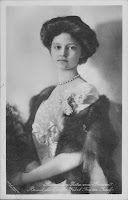![]() |
| Zita 1911 |
We have considered
Bl. Karl of Austria, now we look at his wife
Princess Zita of Bourbon-Parma (Zita Maria delle Grazie Adelgonda Micaela Raffaela Gabriella Giuseppina Antonia Luisa Agnese). She was born in 1892, near Lucca, Italy. She was the seventeenth child of the dispossessed Robert I, Duke of Parma and his second wife, Infanta Maria Antonia of Portugal.
In 1911, Princess Zita married Archduke Karl of Austria, the great-nephew of Emperor Franz-Joseph. This union satisfied dynastic demands but it also represented a marriage between two people bound together by a profound love and nourished by the same Catholic faith.
![]() |
| Engagement |
In 1914, the assassination of the Archduke Franz Ferdinand, Heir to the Throne of Austria-Hungary, left Karl in the position of Heir Apparent to the Emperor. In 1916, when Franz-Joseph died, the young Archduke (he was 29 years old) became Emperor Karl I of Austria, and King Karl IV of Hungary.
During the two years of his reign, from 1916 to 1918, Empress Zita stood by her husband’s side, supporting all of his initiatives. At the same time, the couple led an exemplary life, marked by great piety and blessed by the birth of eight children.
![]() |
| Zita as Empress |
After the end of World War I in 1918, the Habsburgs were deposed when the new countries of Austria, Czechoslovakia, Hungary and the Slovenes, Croats and Serbs States were formed.
By the fall of the next year Austria-Hungary was coming apart forcing Charles and Zita and their family to flee the country to Switzerland. Zita was a great source of strength and comfort to her husband in these hard times and the strain on her had to be great. In 1920 she showed again what she was made of when she accompanied Charles in his effort to regain his throne in Hungary. After both attempts failed the family eventually settled on the Portuguese island of Madeira where Charles died not long after. After her husband's death, Zita and her son Otto served as the symbols of unity for the exiled dynasty.
![]() |
| Zita & Karl with first 4 children |
A widow at the age of 29, expecting a child that would never know her father and lacking any resources, Empress Zita started a long exile moving to Spain and later to Belgium. When Engelbert Dollfuss became chancellor of Austria the possibility of a restoration seemed good but all hopes were ended when Dollfuss was assassinated and Austria was occupied by Germany. World War II and the invasion of Belgium forced the family to flee to the United States where two of her sons joined the American army. Empress Zita contributed by raising money in the US and Canada.
She never remarried and carried on with the same grace and dignity she always showed, raising her children in royal fashion and never giving up hope for a Hapsburg restoration. In 1982 she was finally allowed to return to Austria where she died, still loved and respected by all, in 1989 at the age of 96. Her funeral was attended by 6,000 people, over 200 Hapsburg and Bourbon-Parma royals and a personal representative of Pope John Paul II.
![]() |
| Zita |
On October 3, 2004, Pope John Paul II beatified Emperor Karl. The Church assigned the celebration of the feast day of Blessed Karl of Austria to October 21, the day Zita and he were married. The edifying life of Empress Zita, her unshakeable faith, and her moral strength in adversity make her a model of an exemplary wife and Christian mother. Through her family ties that cross over international borders, Empress Zita is a symbol of peace among the nations. Her cause for canonization has been introduced.
![]() |
| Zita with her 8 children |
![]() |
| Zita & Karl |





